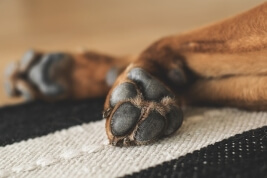 Dogs spend so much time running, jumping, and generally romping around.
It's no surprise, then, that dog foot problems are fairly common. Examine
your dog's paws regularly - think of it as a "preventive" health check!
Doing so can help you identify minor problems before they become most
serious (and more costly) problems. Here's a quick summary of some of
the more common dog foot problems, courtesy of
Scampering Paws:
Dogs spend so much time running, jumping, and generally romping around.
It's no surprise, then, that dog foot problems are fairly common. Examine
your dog's paws regularly - think of it as a "preventive" health check!
Doing so can help you identify minor problems before they become most
serious (and more costly) problems. Here's a quick summary of some of
the more common dog foot problems, courtesy of
Scampering Paws:
Biting, licking, or chewing at her paws often indicate allergies. Your vet can assist you in determining what substances, if anything, your dog is allergic to.
Torn or fractured nails can occur when your dog "catches" the nail on something. This is extremely painful, and the nail should be completely removed by your vet (do not attempt to do this yourself). Eventually the nail should regrow unless the trauma to the nail bed was too severe.
Cuts on the paw aren't uncommon. Dogs run through all sorts of terrain, so a cut isn't uncommon. Wash cuts out and apply an antiseptic ointment. Wrap some gauze around the paw and cover with a soft sock or a dog bootie, if you have one. This helps to prevent your dog from licking at the wound. Large or deep cuts should be examined by your vet. If the cut doesn't appear to heal, starts to look red or begins to "weep", bring your dog to the vet - he may have an infection.
Cracked or dry paw pads can be uncomfortable and even bleed, if the crack is deep. Apply a moisturizer to your dog's paws (check your vet or local pet supply store for moisturizer that's specially formulated for this purpose, or use coconut oil). Don't do it too often, though - your dog relies on "tough" paw pads for walking, and moisturizer can make them too soft and sensitive.
Foreign objects lodged in the paw, whether it's in the pad itself or in between your dog's toes, can be painful and cause dogs to limp or change their gait to try to protect the injured area. Objects include burrs, seeds, dried mud, ice, and even just matted fur. Carefully remove any foreign objects and clip mats - be careful not to nip / damage the "webbing" between your dog's pads.
These are lumps that form in between the dog's paw pads. A vet can perform a fine needle aspirate of the lump to check whether the lump is benign or malignant.
Long toenails should be trimmed. You can do this at home, or if you haven't done it before or are uncomfortable doing so, it can be done at the vet's or at a dog grooming salon. Keeping your pet's nails short will help to prevent torn nails, and keep walking comfortable for your dog. Some dogs prefer the use of a dremel over a nail clipper.
If your dog runs a great deal, especially over rough terrain or in very hot or very cold conditions, consider investing in a set of dog boots. It takes most dogs a bit of getting used to, but the boots can save your dog's paws from excessive discomfort or injury. Dog paw problems can occur at any time since our canine pals love to run and play - so keep a watchful eye out for potential issues that may need treatment.
"Marley taught me about living each day with unbridled exuberance and joy, about seizing the moment and following your heart. He taught me to appreciate the simple things - a walk in the woods, a fresh snowfall, a nap in the shaft of winter sunlight." (John Grogan)